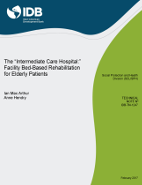The "Intermediate Care Hospital": Facility Bed-Based Rehabilitation for Elderly Patients
Date
Feb 2017
Population aging and the growing burden of chronic disease are causing many countries to explore new options as they reorganize their health systems from acute care toward increased chronic care provision. There are several modalities to deliver recuperative intermediate care at a level between the hospital and primary care, but some patients will require a bed-based solution. For these individuals, inpatient non-acute facilities may provide superior outcomes at a lower cost than traditional care on a hospital ward. The international literature regarding this type of service reveals positive findings on provider and patient satisfaction, clinical outcomes, and cost-effectiveness. However, to achieve the best possible results, providers must establish and apply appropriate procedures for the identification of eligible patients, exercise rigorous protocols during their transfer, and ensure their comprehensive assessment and adhesion to a therapeutic plan managed by a multidisciplinary team. For developing countries considering the formulation of policies to promote the implementation of intermediate care facilities, Brazil's recent experience may offer a point of reference and some guidance, especially in terms of reconditioning small community hospitals with excess capacity for this purpose.




